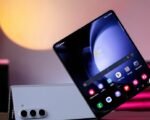Galaxy Z Fold7 goes lighter, slimmer, and sleeker—but will it be enough to win back the foldable crowd?
Samsung is betting big—and thin—on its latest foldable, the Galaxy Z Fold7. With its lightest and slimmest design yet, the company is trying to breathe new life into a market that, despite all the buzz, just hasn’t taken off the way many expected.
For all the hype around foldable screens, they still make up a tiny sliver of global smartphone sales. Now, with mounting pressure from Chinese rivals and a wave of consumer fatigue, Samsung is sharpening its edge.
A thinner design, a bigger bet
After years of playing it relatively safe, Samsung finally hit the reset button. The Galaxy Z Fold7 and its smaller sibling, the Flip7, look and feel more like traditional phones—at least when closed. That’s no accident.
The Fold7 now folds down to a thickness that’s almost indistinguishable from standard premium smartphones, a feat that would’ve sounded borderline science fiction just five years ago. It also weighs noticeably less, which is no small deal for people who’ve gotten tired of lugging around what used to feel like two phones stacked together.
That’s not just cosmetic.
“It’s a huge leap,” said Ben Wood of CCS Insight. “Samsung’s gone from being risk-averse to putting something bold and polished out there.”

Still niche after all these years
Foldable phones have been floating around since 2018, when China’s Royole debuted the FlexPai—now mostly forgotten after the company filed for bankruptcy in 2024. But even with Samsung jumping in soon after, things never quite caught fire.
Today, foldables make up just 2% of global smartphone shipments. That’s shockingly low for a category that once promised to change how we use phones entirely.
Much of the blame comes down to three words:
-
Price
-
Camera
-
Thickness
The Fold7 tries to check all three boxes. But even at $2,000 for the Fold and $1,100 for the Flip, cost remains a hurdle for average buyers. Many consumers just aren’t ready to shell out double the price of a standard phone for the cool factor of a fold.
Competition heating up fast
Samsung may have been the early king of foldables, but its lead is slipping. Fast.
Chinese brands like Honor and OnePlus are aggressively moving in. Motorola, of all companies, has made a serious comeback with its Razr foldables. And they’re doing it with sharper cameras, sleeker builds, and often at lower prices.
Samsung knows it can’t afford to coast anymore.
“Honor and others are nipping at Samsung’s heels, and they’ve pushed the bar on what foldables should look and feel like,” said Avi Greengart of Techsponential.
Hardware gets the shine—but software matters now
It’s not just about getting a thinner hinge or hiding the crease. Samsung has also invested in the software that makes a foldable more than just a gimmick.
Apps now scale better when switching from phone to tablet mode. Split-screen multitasking feels more natural. And UI tweaks make using the big inner screen more fluid. Samsung even worked with Google to make Android foldable-friendlier.
One small paragraph here.
Greengart summed it up like this: “This isn’t just a phone that folds—it’s a tablet with real software chops.”
Who’s actually buying these things?
Despite all the talk, foldables are still a luxury purchase. And the people buying them fall into one of three camps:
-
Techies who want to try the latest gadget
-
Professionals using them as a productivity tool
-
Fashion-conscious users who like the “wow” factor
That’s a pretty narrow slice of the market.
And let’s be honest—at $2,000 a pop, most people are sticking with their iPhones or Android flagships. That said, Samsung hopes the thinner, more practical design might finally nudge hesitant buyers into giving foldables a chance.
Table: Foldables vs Traditional Smartphones
Here’s how the Fold7 stacks up against regular flagships:
| Feature | Galaxy Z Fold7 | Galaxy S24 Ultra | iPhone 15 Pro Max |
|---|---|---|---|
| Starting Price | $2,000 | $1,200 | $1,199 |
| Folded Thickness | 11.2 mm | 8.9 mm | 8.3 mm |
| Weight | 239 g | 233 g | 221 g |
| Rear Camera Quality | 50MP Triple Lens | 200MP Quad Lens | 48MP Triple Lens |
| Main Display | 7.6” Foldable AMOLED | 6.8” Flat AMOLED | 6.7” Super Retina XDR |
That thickness drop really does make a difference. Just a few millimeters, but it feels like a whole different device in your hand.
The foldable future: Maybe not dead yet
There’s no guarantee this relaunch will spark a full-blown revival of foldables. The average consumer still sees them as too pricey, too delicate, or too extra.
But Samsung clearly isn’t giving up. And this new release signals it’s not ready to let others define the space it pioneered.
Younger audiences, especially in Asia, seem more open to experimenting. If the price comes down—and if the tech keeps getting better—foldables could still find their place in the mainstream.
Right now, though, they’re still a bit of a status symbol.
Still, for once, it feels like Samsung isn’t just iterating—it’s swinging back.








